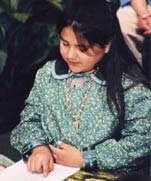Teaching Methods

Happy historians learn about life in the 1800s.
Copyright © 2002 Smithsonian National Museum of American History | Photograph by Jack Iwata, courtesy of the National Archives.
View largerThe OurStory and The Story in History programs combine the exploration of the Museum's collections, hands-on learning, quality children's literature, and storytelling to bring history to life for families and students. Hands-on learning and literature are powerful tools in engendering a love of history in children.
Literature and storytelling are powerful tools in helping children develop a love of history.
The OurStory and Story in History programs are designed to:
- Provide visitors an opportunity to make meaningful connections with history through Museum objects, children's literature, and multidisciplinary hands-on activities.
- Foster an environment in which participants of different generations and cultural backgrounds interact, share, learn from one another, and begin to see themselves as part of American history.
- Broaden participants' understanding of the history of diverse communities and cultures within the United States.
- Encourage future museum visits by introducing visitors of all ages to educational and enjoyable ways to explore the Museum.
Learning through Objects and Story
Objects are powerful. They have the ability to stimulate interest in and imagination about the stories of the past. Objects from the past help us understand earlier times and places and stir memories in young and old alike. Exploring the past through the hands-on use of reproduction objects dramatically enriches a young learner's experience. The stories of ordinary people of the past help children begin to see themselves as part of the fabric of the American story.
Object-based interactive experiences ignite children's curiosity and stimulate their interest in history. Sensory-rich experiences that enable children to learn in ways that appeal to their learning styles and interests empower them and contribute to their sense of ownership of the Museum experience. Hands-on participation also increases retention. A person who listens to a description of an activity remembers only 10 percent of what he/she heard, but will retain 90 percent of what he/she experiences while doing the same activity.
Children's literature and storytelling are two other important tools for fostering an interest in the past. The use of story helps create a context for understanding. Combining hands-on experiences and story makes learning experiences even more stimulating and unforgettable. Hearing someone explain how to make a rug may be interesting, but exploring the Navajo Weaving activity in the Hands on History Room while listening to the legend of how Spider Woman taught the Navajo to weave is truly memorable.
As a result of these strategies, children become more inquisitive and enjoy the Museum visit, and are therefore more likely to become lifelong learners and museum visitors.


